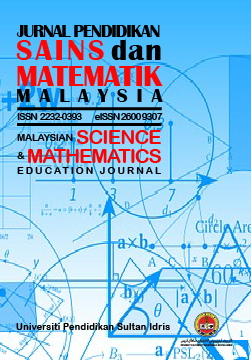Science Teachers' Conceptions and Perceptions of Scientific Creativity and Approaches to Nurture It in Science Teaching and Learning in Secondary School
Kefahaman dan Persepsi Guru Sains tentang Kreativiti Saintifik serta Pendekatan untuk memupuknya dalam Pengajaran dan Pembelajaran Sains Sekolah Menengah
DOI:
https://doi.org/10.37134/jpsmm.vol11.1.9.2021Keywords:
Scientific creativity, science education, creativity in science, creativity applicationAbstract
In Malaysia, educational researchers, educators and teacher have supported the need to foster students’ creativity via a national curriculum. Aspects of creativity are different across domains and in science subjects, fostering students’ creativity will lead to scientific creativity. The overall aims of this study were to explore science teachers’ conception and perception towards fostering scientific creativity in the science classrooms. The study has a qualitative nature that stands on an interpretive worldview. The methodology involved eight science subject teachers as informants and using semi-structured interviews to collect data. Thematic findings and case studies findings were drawn from the analysis of the data collected. In general, the thematic findings indicated that science teachers are able to define the meaning of creativity and its main aspects. Teacher’s pedagogical perception enforce eight teaching approaches to foster creativity in the science classroom: (1) application of thinking skills, (2) exposure to science examples, (3) inter-discipline science learning, (4) technology-based learning, (5) inquiry-based learning, (6) cooperative learning, (7) practical investigation (experimentation) and (8) project-based learning. The teachers believe that these approaches could promote students’ scientific creativity in science classroom when specific factors facilitate or hinders the effectiveness of such approaches in terms of fostering creativity.
Downloads
References
Abd-El-Khalick, F., Boujaoude, S., Duschl, R., Lederman, N. G., Mamlok-Naaman, R., Hofstein, A., … Tuan, H. L. (2014). Inquiry in science education: International perspectives. Science Education, 88(3), 397–419. https://doi.org/10.1002/sce.10118
Aktamis, H., & Ergin, O. (2008). The effect of scientific process skills education on students’ scientific creativity, science attitudes and academic achievements. In Asia-Pacific Forum on Science Learning and Teaching (Vol. 9, pp. 1–21).
Amabile, T. M. (1983). The Social Psychology of Creativity. Springer-Verlag New York Inc. https://doi.org/10.1080/02640828708723925
Andiliou, A., & Murphy, P. K. (2010). Examining variations among researchers’ and teachers’ conceptualizations of creativity: A review and synthesis of contemporary research. Educational Research Review, 5(3), 201–219. https://doi.org/10.1016/j.edurev.2010.07.003
Ayas, M. B., & Sak, U. (2014). Objective measure of scientific creativity: Psychometric validity of the creatives scientific ability Test. Thinking Skills and Creativity, 13, 195–205. Retrieved from http://www.sciencedirect.com.www.ezplib.ukm.my/science/article/pii/S1871187114000327
Cevher, A. H., Ertekin, P., & Koksal, M. S. (2014). Investigation of scientific creativity of eighth grade gifted students. International Journal of Innovation, Creativity and Change, 1(4).
Demir, S. (2015). Perspectives of science teacher candidates regarding scientific creativity and critical Thinking. Journal of Education and Practice, 6(17), 157–160.
Feldman, D. H., Csikszentmihalyi, M., & Gardner, H. (1994). Changing the world: A framework for the study of creativity. Westport, CT, US: Praeger Publishers/Greenwood Publishing Group.
Huang, P. S., Peng, S. L., Chen, H. C., Tseng, L. C., & Hsu, L. C. (2017). The relative influences of domain knowledge and domain-general divergent thinking on scientific creativity and mathematical creativity. Thinking Skills and Creativity, 25(48), 1–9. https://doi.org/10.1016/j.tsc.2017.06.001
Liu, S. C., & Lin, H. shyang. (2014). Primary teachers’ beliefs about scientific creativity in the classroom context. International Journal of Science Education, 36(10). https://doi.org/10.1080/09500693.2013.868619
Lu, Y. L., Lian, I. Bin, & Lien, C. J. (2015). the Application of the Analytic Hierarchy Process for Evaluating Creative Products in Science Class and Its Modification for Educational Evaluation. International Journal of Science and Mathematics Education, 13(May), 413–435. https://doi.org/10.1007/s10763-013-9485-x
Ndeke, G. C. W., Okere, M. I. O., & Keraro, F. (2015). Influence of Gender and Knowledge on Secondary School Students’ Scientific Creativity Skills in Nakuru District, Kenya. European Journal of Educational Research, 4(9). https://doi.org/10.1080/09500690110098912.Hungi
Newton, L. D., & Newton, D. P. (2010). What teachers see as creative incidents in elementary science lessons. International Journal of Science Education, 32(15), 1989–2005. https://doi.org/10.1080/09500690903233249
Nooraishah, K. (2004). Penguasaan aspek kemahiran berfikir secara kritis dan kreatif di dalam mata pelajaran sains KBSM dikalangan pelajar tingkatan empat daerah Kuala Langat. Universiti Teknologi Malaysia.
Norfauzi, M. (2002). Kajian mengenai tahap kreativiti di kalangan pelajar tingkatan empat di daerah Jasin, Melaka. Universiti Teknologi Malaysia.
Nur Cayirdag. (2017). Creativity Fostering Teaching: Impact of Creative Self-efficacy and Teacher Efficacy. Educational Sciences: Theory & Practice, 17(6), 1959–1975. https://doi.org/10.12738/estp.2017.6.0437
Okere, M. I., & Ndeke, G. C. (2012). Influence of Gender and Knowledge on Secondary School Students’ Scientific Creativity Skills in Nakuru District, Kenya. European Journal of Educational Research, 1(4), 353–366. https://doi.org/10.12973/eu-jer.1.4.353
Roslinda, G. (2007). Tahap penguasaan kemahiran berfikir kritis dan kreatif (kbkk) dalam matapelajaran fizik di kalangan pelajar tingkatan empat. Universiti Teknologi Malaysia.
Siew, N. M., Chin, M. K., & Sombuling, A. (2017). The effects of problem based learning with cooperative learning on preschoolers’ scientific creativity. Journal of Baltic Science Education, 100–113. https://doi.org/10.1177/001698629203600405
Siew, N. M., Chong, C. L., & Chin, K. O. (2014). Developing a scientific creativity test for fifth graders. Problems of Education in the 21st Century, 62(1974), 109–123.
Siew, N. M., Chong, C. L., & Lee, B. N. (2015). Fostering fifth graders’ scientific creativity through problem-based learning. Journal of Baltic Science Education, 14(5), 655–669.
Siti Hajar, A. (2008). Tahap kreativiti di kalangan pelajar program sains di fakulti pendidikan. Universiti Teknologi Malaysia.
Siti Salbiah, O., Noor Dayana, A. H., Johari, S., & Jamalludin, H. (2012). A pilot study on chemistry creativity test for Malaysian science students. ICEHOTS.
Su Ling, L., Pang, V., & Lajium, D. (2020). A Case study of teachers’ pedagogical content knowledge in the implementation of integrated STEM education. Jurnal Pendidikan Sains Dan Matematik Malaysia, 10(1), 49-64.
Suriyana, D. (2004). Tahap penguasaan kemahiran berfikir secara kritis dan kreatif dalam mata pelajaran sains di kalangan pelajar tingkatan dua di sekolah daerah kuala terengganu. Universiti Teknologi Malaysia.
Usta, E., & Akkanat, C. (2015). Investigating scientific creativity level of seventh grade students. Procedia Social and Behavioral Sciences, 191, 1408–1415. https://doi.org/10.1016/j.sbspro.2015.04.643





